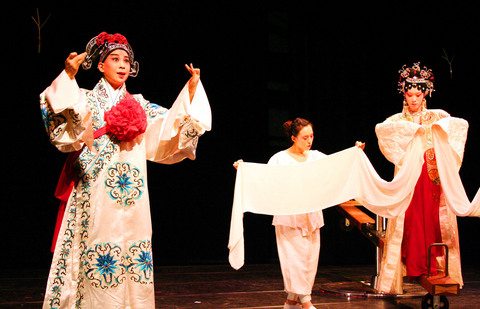From the mists of the Ming Dynasty comes a contemplative and philosophical play that combines high pathos with low comedy in a work that has left its mark on generations of kunqu (崑曲) opera troupes and productions.
1/2Q Theater (二分之一Q劇場) — formed a little under a year ago — has emerged as one of Taiwan's preeminent experimental kunqu opera troupes. It will perform Nanke Story (戀戀南柯) this weekend at the National Experimental Theater as the second play of the New Idea Theater festival.
According to Yang Han-ju (楊汗如), one of troupe's lead actors, the "1/2" in the title symbolizes their desire to have one foot on the traditional kunqu camp with the other firmly planted in the contemporary theater scene. "The 'Q' is a play on words and represents kunqu," she said.

PHOTO COURTESY OF NTCH
As with many modern adaptations of Chinese classics, the contemporary aspect of the production is most clearly visible with the stage design — created by 2004 Tai Shin Arts Award winner Shy Gong (施工忠昊) — featuring a circling seesaw and overhead projection.
The 600 year-old kunqu style of opera comes from the Kunshan district of Jiangsu Province in southern China. Though music plays an important role in the opera, it is first and foremost a performing art and is one of the oldest and most refined styles of Chinese theater. A synthesis of drama, music and poetry, the lines of verse spoken by the actors are also expressed by stylized movement, with strict attention paid to the execution of each gesture, where even the most casual movement must be timed to coordinate with the music. Typically, most kunqu plays would take several days to perform, like the recently well-received The Peony Pavilion, which ran for nine hours and was presented over three evenings.
Fortunately, for those who don't have the time or energy to sit through three days of Chinese opera, Nanke Story weighs in at under 90 minutes. But if the length of the opera is relatively short for the genre, playwright Shen Hui-ju (沈惠如) closely adheres to the classical Chinese used in the original work.
But the language shouldn't inhibit theatergoers as Nanke Story, like The Peony Pavilion, has been translated into English and is easily available. Both plays were written by the renowned Ming Dynasty playwright Tang Xianzu (湯顯祖), and form two of the four plays written by the author collectively known as the "Four Dreams" because of the decisive role dreams play in the plot of each.
Nanke tells the story of a discharged army officer who one day dreams that he enters an ant hole and ends up marrying the daughter of the king of ants. After the marriage, the officer is appointed to a high position in the king's administration and pursues a prestigious career until his wife dies. His downfall is then engineered by one of his political rivals, resulting in his eventual banishment from the kingdom. After he is kicked out of the kingdom, he awakes from his dream.
Though the play is difficult to classify using traditional western standards, the playful stage design combined with the poetic language creates an atmosphere of fun and desolation that parallels the satiric intentions of the original work.

June 9 to June 15 A photo of two men riding trendy high-wheel Penny-Farthing bicycles past a Qing Dynasty gate aptly captures the essence of Taipei in 1897 — a newly colonized city on the cusp of great change. The Japanese began making significant modifications to the cityscape in 1899, tearing down Qing-era structures, widening boulevards and installing Western-style infrastructure and buildings. The photographer, Minosuke Imamura, only spent a year in Taiwan as a cartographer for the governor-general’s office, but he left behind a treasure trove of 130 images showing life at the onset of Japanese rule, spanning July 1897 to

One of the most important gripes that Taiwanese have about the Democratic Progressive Party (DPP) is that it has failed to deliver concretely on higher wages, housing prices and other bread-and-butter issues. The parallel complaint is that the DPP cares only about glamor issues, such as removing markers of Chinese Nationalist Party (KMT) colonialism by renaming them, or what the KMT codes as “de-Sinification.” Once again, as a critical election looms, the DPP is presenting evidence for that charge. The KMT was quick to jump on the recent proposal of the Ministry of the Interior (MOI) to rename roads that symbolize

On the evening of June 1, Control Yuan Secretary-General Lee Chun-yi (李俊俋) apologized and resigned in disgrace. His crime was instructing his driver to use a Control Yuan vehicle to transport his dog to a pet grooming salon. The Control Yuan is the government branch that investigates, audits and impeaches government officials for, among other things, misuse of government funds, so his misuse of a government vehicle was highly inappropriate. If this story were told to anyone living in the golden era of swaggering gangsters, flashy nouveau riche businessmen, and corrupt “black gold” politics of the 1980s and 1990s, they would have laughed.

It was just before 6am on a sunny November morning and I could hardly contain my excitement as I arrived at the wharf where I would catch the boat to one of Penghu’s most difficult-to-access islands, a trip that had been on my list for nearly a decade. Little did I know, my dream would soon be crushed. Unsure about which boat was heading to Huayu (花嶼), I found someone who appeared to be a local and asked if this was the right place to wait. “Oh, the boat to Huayu’s been canceled today,” she told me. I couldn’t believe my ears. Surely,